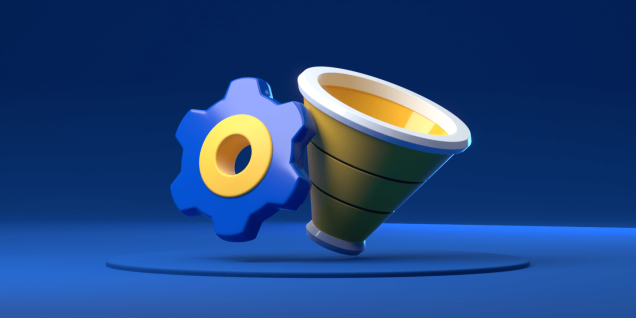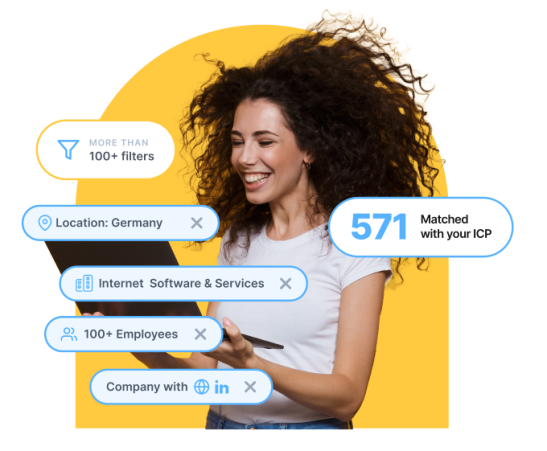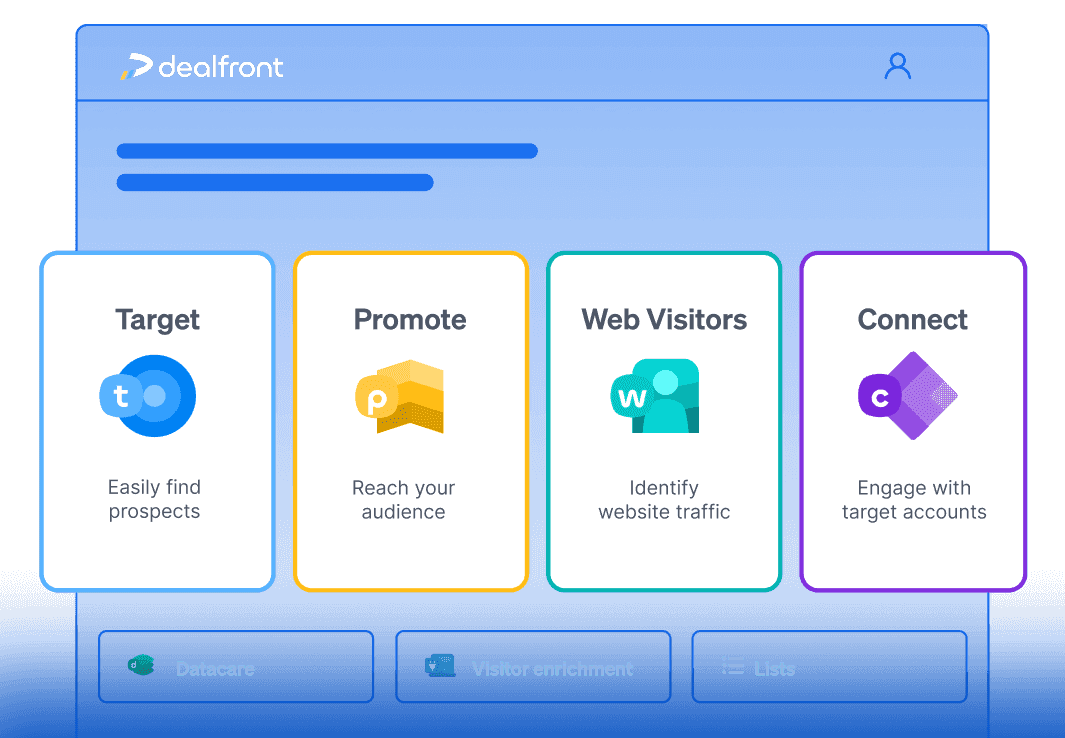The B2B sales cycle is naturally long-winded and complex because B2B buyers take their time before purchasing a product or service. If you don’t find innovative ways to optimize your sales funnel, you’ll spend substantial time on administrative tasks rather than high-value sales tasks.
Embracing automation is an effective and impactful way of optimizing your B2B sales funnel. With B2B sales automation, you can accelerate your sales cycle significantly as you get more time and tools to focus on hard-core sales and marketing tasks.
If you don’t capitalize on B2B sales funnel automation today, you’ll have a hard time succeeding in a highly competitive B2B business market. But don’t sweat it if you don’t know how to implement B2B sales automation because Dealfront has your back.
In this guide, we’ll define the B2B sales funnel and show you the step-step process of automating your sales funnel. You’ll also learn what are the best automation tools to use and common mistakes to avoid during implementation. And to get a practical perspective, we’ll review three real-world B2B companies that have used sales funnel automation successfully.
Let’s jump in.
What is a B2B sales funnel?
A B2B sales funnel describes the stage-by-stage process B2B buyers go through to complete a sales cycle. It starts from the first interaction when they search for your product, service, or brand to the last touch point when they purchase. Simply put, a B2B sales funnel is an illustration of the buyer’s journey.
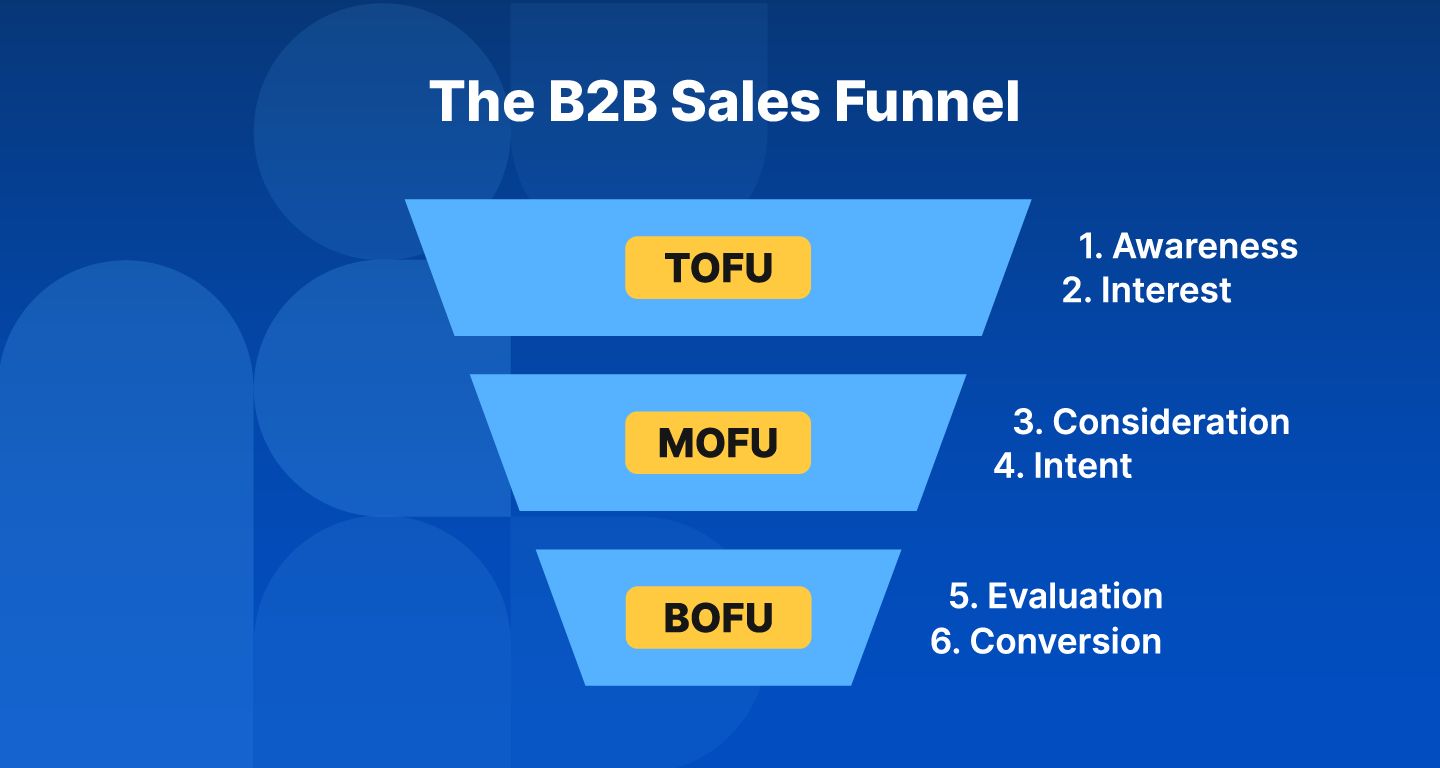
Key stages of a B2B sales funnel
Although B2B companies may have different sales funnel representations depending on their individual buyer’s journey, they all follow these three key stages:
Top of the funnel (TOFU)
TOFU, also called the Awareness & Discovery stage, is the initial phase where the prospects discover your brand or service/product offering for the first time. Here, you capitalize on TOFU content like blog posts, landing pages, infographics, and ads to generate awareness and let potential B2B buyers know your brand or solution exists.
This is the stage in which you start developing your content marketing strategy.
Middle of the funnel (MOFU)
MOFU, or the Evaluation stage, is the next stage, where your target audiences show interest and engagement in your brand’s solutions. At this stage, they’re more concerned if your solution is the best fit for their pain points over if you’re the best market vendor to work with. You should, therefore, aim to educate and offer problem-specific solutions that sell your brand as the go-to thought leader.
Because B2B decision-makers spend 45% of their buying time doing independent solution-based research, you’ll want to leverage MOFU content like expert interviews, case studies, whitepapers, and solution briefs to give them enough resources to conduct thorough research.
Bottom of the funnel (BOFU)
BOFU, or the Conversion stage, is the last stage of the sales funnel where prospects prepare to make a purchase. They’ve already established that your brand’s solution solves their pain points and set a working budget. Thus, your BOFU content should close and convert potential customers to paying customers.
Some of the strategies you can use to convert prospects at the BOFU stage include:
Initiate contact by phone, in person, or via mail to persuade prospects.
Offer introductory pricing on their preferred packages.
Use testimonials, client reviews, and recommendations.
Offer free training and customer support.
Write compelling calls-to-action (CTA).
At the BOFU stage, you should differentiate your brand’s solutions and demonstrate to your B2B prospects the advantages of choosing your company over competitors.
The role of automation in B2B sales funnels
Businesses work hard to nurture a B2B prospect from the TOFU to the BOFU stage. Understandably, there’s a lot of manual and repetitive work involved. These tasks include:
Sending follow-up emails and product-based alerts
Distributing content to prospects at different stages on different platforms
Attending to customer queries on multiple channels
Updating customer data in real-time
The role of automation is to computerize some or all of your repetitive sales tasks. When you employ automation to handle such tasks, you’ll have more time to cater to core lead-nurturing tasks like conducting customer surveys and sales prospecting.
A tried and tested B2B sales prospecting solution can help you automate most prospecting activities, like filtering prospect lists and determining the right time to contact your prospects, thereby optimizing your B2B sales funnel strategy.
The benefits of automating your B2B sales funnel
Sales funnel automation yields the following key benefits for your B2B company:
Increased efficiency and productivity
The competitive nature of today’s B2B market calls for next-level efficiency and productivity to keep up with the many moving parts of the B2B sales cycle. Without automation, you may be busy working on seemingly important tasks, but they may not generate leads or revenue in the long run.
For instance, responding to potential customers’ questions is indeed a fundamental part of lead nurturing. But if you spend most of your time crafting customized responses to each query, you’ll fall behind competitors who automate this task.
On the contrary, if you automate customer service response tasks, you’ll have more time, energy, and resources to work on more productive lead and revenue-generating tasks. Unsurprisingly, 45% of B2B marketers who use marketing funnel automation enjoy enhanced efficiency.
And if you’re among the 61% of marketers who see lead generation as a top challenge, you’ll want to leverage automation to make your lead-generation efforts more efficient and productive. Overall, even if you only utilize automation to boost your lead nurturing efficiency, it would still be a substantial win in your B2B sales cycle.
Improved lead scoring and segmentation
The benefits of automation stretch beyond lead generation. And this is great because lead scoring and segmentation are as important as generation. In fact, your lead generation efforts may not yield the desired results if you don’t qualify your leads effectively.
Scoring new leads involves installing a marketing automation system that ranks prospects per their buyers’ stage. You utilize a lead scoring model that tracks, evaluates, and qualifies prospects depending on their engagement levels and user behavior.
The user actions of qualified leads include:
Clicking email links
Browsing product pages
Requesting product demos
Signing for free trials
Opening CTA links
Requesting price discounts
Suggesting feature updates
You can program your automation system to automatically assign points to each user action and match it to its respective stage in the sales funnel. This allows you to develop multiple segments according to prospects’ engagement levels. With different segments, you can target your marketing outreach accordingly and ultimately increase your conversion rate.
Enhanced customer relationship management
At the very least, the modern B2B customer expects personalized customer service and management. To deliver an exceptional customer experience, you must know their brand and industry inside out and develop a strong relationship with the key B2B decision makers.
You require updated customer data to curate a personal experience for your prospects and existing customers. And this is where automation saves the day. Using an elite customer relationship management (CRM) system, you can track and record important data points of your B2B buyers and their companies.
For instance, if a B2B decision maker in one of your client’s B2B companies gets promoted and acquires a new job title, you would only make a one-off adjustment to your CRM. This way, all correspondences to that person would automatically include the new title.
Better yet, you can enhance customer service quality by enriching customer data in your CRM using an innovative solution like Dealfront Datacare. This solution utilizes a variety of intelligent features such as data enrichment, reachability checking, the detection of company forms (LLC, Inc., etc.), and address changes. It helps you align your customer service offering with the most recent data changes of your B2B customers.
Essential tools for automating your B2B marketing funnel
While you can utilize many automation tools for your B2B sales funnel, you shouldn’t pick the first all-in-one tool you find and hope it will meet all your needs. It’s more prudent to establish the B2B functions that will yield the most gains if you automate and prioritize the automation tools customized for those functions.
Here’s a rundown of the top automation software and tools in four categories you can leverage to your advantage:
Customer relationship management (CRM) systems
CRM is fundamental in B2B marketing as it helps build more impactful relationships with prospects and customers, fostering customer loyalty and satisfaction. By automating CRM functions such as tracking customer interactions and customer ticket processing, you enhance your company's success rate.
Five top-rated CRM tools you can use for this purpose include:
Monday Sales CRM
HubSpot CRM
Salesforce CRM
Pipedrive
Zoho CRM
Email marketing automation tools
Email marketing is one of the first functions B2B marketers seek to automate because, despite its exceptional efficiency, it requires a lot of work and repetitive tasks. Thus, there are many email automation tools at your disposal. They include:
Mailchimp
ActiveCampaign
Customer.io
Constant Contact
Drip
Automizy
Social media management tools
These tools will help you stay on top of all your social media platforms so you can share product updates in real time across all platforms:
Hootsuite
CoSchedule
Buffer
Sprout Social
BuzzSumo
Analytics and reporting tools
These tools will help you analyze your B2B customer data and marketing campaign results so you can make data-driven decisions:
Salespanel
Tableau
Google Analytics
Adobe Analytics
Mixpanel
In the best-case scenario, you should purchase the top-rated automation tool for each function. However, if you can’t afford separate tools, consider using a reliable all-in-one automation tool like HubSpot or Marketo.
Step-by-step guide to automate your B2B sales funnel
Here's how you can build an automated sales funnel like a pro:
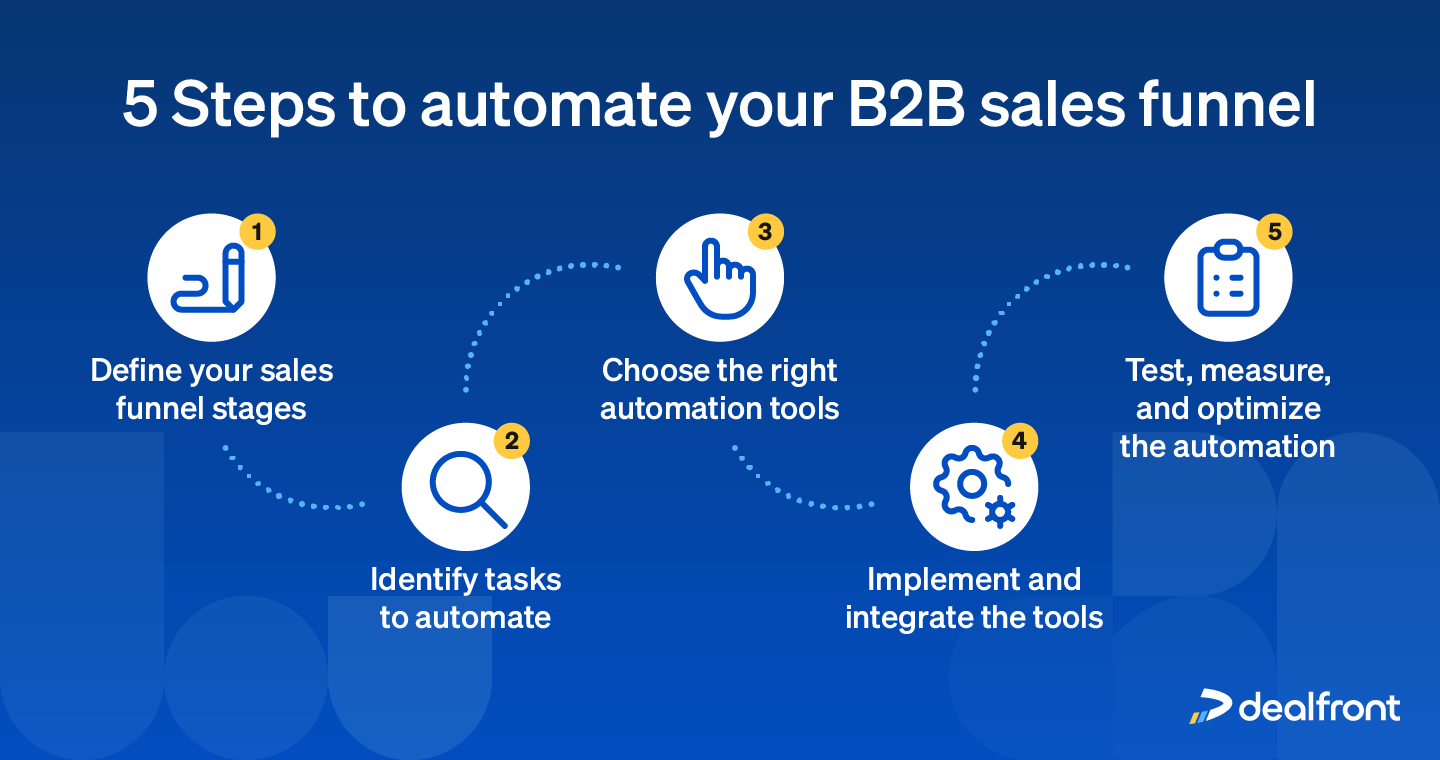
Step 1: Define your sales funnel stages
Map out your customer journey stage by stage to build a sales funnel unique to your company. While it’s best to create a new sales funnel specific to your company, you can draw inspiration from the known sales funnel models such as:
AIDA (Attention, Interest, Desire, and Action) model
PAS (Problem, Agitation, and Solution) model
Marketing RaDaR (Reach and Depth and Relationship) model
ACID (Awareness, Consideration, Intent, and Decision) model
Step 2: Identify tasks to automate
For each sales funnel stage, pinpoint the functions that are the best candidates for automation. Prioritize the tasks that consume the most time, energy, and resources. For instance, if you send daily email alerts to your existing and new customers, you may want to automate these emails ahead of your prospecting emails.
Step 3: Choose the right automation tools
After mapping out the tasks you wish to automate in each sales funnel stage, research and find the automation tools that best execute those functions. Additionally, consider if the tools will integrate well with your existing IT infrastructure to avoid making costly upgrades.
Step 4: Implement and integrate the tools
To get to value quickly and achieve optimal operational efficiency, take time to integrate your automation tools with your company’s IT system. Early implementation gives you ample time to spot data and system integration gaps that impede the tool’s performance. This way, you’ll have enough wiggle room to make the necessary adjustments to avoid future logjams.
Step 5: Test, measure, and optimize the automation
After implementing your automation tools for a reasonable period (ideally long enough to experience a full business cycle), test, measure, and optimize the results. This process helps you decide if the automation tool is productive and if you should stick with it or find alternatives.
Case studies of successful B2B sales funnel automation
These are three elite B2B companies that have achieved milestones thanks to sales automation:
Case study 1: The Expert Institute
After running a single email marketing automation campaign, the Expert Institute registered a 200% rise in conversions, a 20% hike in click-through rate, and a 60% increase in email open rate.
Case study 2: Brainshark
Brainshark, a B2B SaaS provider, turned to marketing funnel automation to help convert its freemium users into paying customers. After embracing marketing automation, Brainshark started delivering personalized messages that triggered a 15% rise in online registrations.
Case study 3: CentricsIT
After realizing that manual lead nurturing and email marketing efforts weren’t working, CentricsIT switched to marketing automation technology. This yielded a 59% increase in lead generation and $1.5 million in associated revenue.
Common mistakes to avoid in B2B sales funnel automation
Watch out for these commonplace mistakes B2B marketers often commit when implementing sales funnel automation.
Neglecting the human touch in the sales process
Automation shouldn’t eliminate the human touch aspect of your B2B sales process. While you can automate all or most of your TOFU and MOFU content, your BOFU content, like explainer videos, should have a strong human touch.
Remember, your B2B buyers are real-life persons making a purchase decision on behalf of their companies. As such, they’ll feel more confident in your brand’s products and services when they know real humans are behind their marketing solutions and strategies. B2B buyers expect to interact with expert and seasoned customer service agents who will help them make an informed purchase decision.
That’s why most B2B companies assign a dedicated account manager from their sales teams to B2B prospects who reach the BOFU stage.
Over-automation of the sales funnel
While B2B buyers expect you to automate sections of your sales funnel, they won’t love it as much when you go overboard with automation. For instance, if B2B prospects initiate a price negotiation, they would expect you to call them and have a verbal negotiation or visit them for an in-person negotiation.
This is because even though customer service bots are efficient and prompt, they can’t replace the personal and instinctual response of a human customer service agent, especially in far-reaching matters like price negotiations.
Ignoring the importance of testing and optimization
Sales funnel automation isn’t a set-it-and-forget-it strategy. Even if your automation tools yield immediate results, you should keep optimizing them to see if you can build on the existing efficiencies.
You do this by testing and comparing different metrics of your automation campaigns against their respective KPIs (Key Performance Indicators). Depending on the results, you can better decide whether to continue using the automation tools or switch them up. Some of the crucial metrics you should track include:
Email open rate
Click-through rate
Conversion rate
Engagement and bounce rate
Some of the funnel testing methods you can leverage include:
A/B testing
Funnel sequencing
Multivariate testing
User testing
Conclusion
Without an exceptional sales funnel automation strategy, you’ll likely fall behind the pecking order in a super-competitive B2B sector. Thankfully, you can reference this guide to automate your B2B sales funnel successfully. By integrating cutting-edge sales automation software into your workflow, you can streamline processes and stay ahead of the curve.
